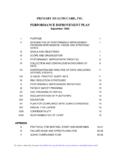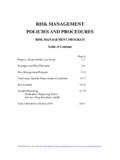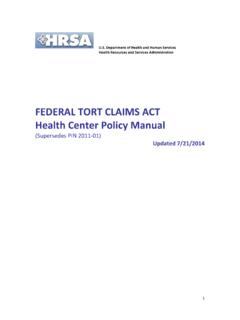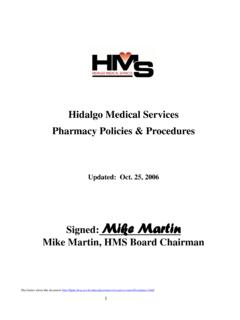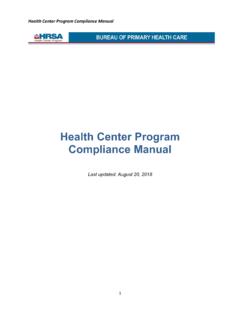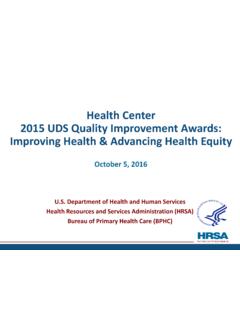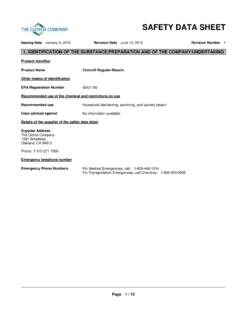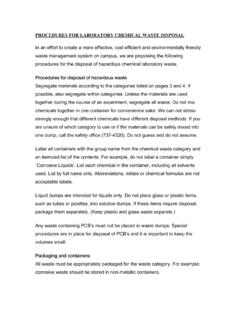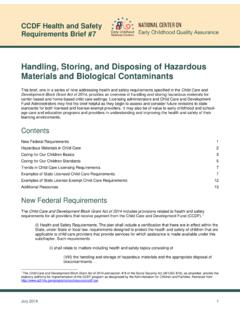Transcription of FAQ: NEPA Environmental Assessments
1 FAQ: NEPA Environmental Assessments An Environmental Assessment (EA) under the National Environmental Policy Act (NEPA) is a concise public document that provides sufficient evidence and analysis for determining whether HRSA should issue a Finding of No Significant Environmental Impact (FONSI) or prepare an Environmental Impact Statement (EIS). It is designed to help public officials make decisions that are based on an understanding of the human and physical Environmental consequences of the proposed project and take actions, in the location and design of the project, that protect, restore and enhance the environment. Note: A Phase 1 Environmental Site Assessment (ESA) is NOT the same as a NEPA EA: A Phase 1 ESA relates only to the requirements of the Comprehensive Environmental Review, Compensation and Liability Act (CERCLA, commonly known as Superfund), which pertains to hazardous substances. A Phase 1 ESA addresses only a small part of what is required for an overall NEPA EA and will not fully meet the requirements of a NEPA EA.
2 A NEPA EA is a comprehensive study that identifies Environmental impacts of a land development action and analyzes a broad set of parameters including biodiversity, Environmental justice, wetlands, air and water pollution, traffic, geotechnical risks, public safety issues and also hazardous substance issues. HRSA recommends that grantees ensure that their consultants are undertaking the correct Environmental reviews. Please ensure that your consultants working on proposed projects are aware of this distinction to avoid any delays in HRSA s reviews. Project timelines should realistically include the time for preparation, review, and public comment for the Environmental Assessment. Actual site preparation and construction work cannot proceed until the EA is completed and adopted by the HRSA. The Environmental Assessment Review Process Preparation of a draft Environmental Assessment (EA) may be required by HRSA if the grantee is undertaking new construction or expansion of an existing facility, or is engaging in extensive alteration and renovation.
3 The Notice of Grant Award will identify the Environmental compliance requirements initially determined for the project(s). If there is no existing EA, the grantee must prepare an EA after identifying the proposed site. In order to adequately assess all of the potential Environmental impacts, a multi-disciplinary team must be used to perform the Environmental analysis. Any state or local Environmental impact review requirements should also be incorporated into the EA process. If the proposed project already has a completed EA that is in compliance with the requirements of the National Environmental Policy Act (NEPA), and has already been prepared another Federal agency, please submit it for HRSA consideration. If you 2 have been instructed by HRSA to prepare a draft EA, please be aware that it may take between one and three months to prepare a draft EA for HRSA review. The document will then need to be uploaded to the appropriate condition submission in the Electronic Handbook for HRSA to begin its review and approval.
4 Because this is a comprehensive review, HRSA requires on average 45 days for review of the draft Environmental Assessment. If the document is incomplete, or indicate other issues such as floodplain, wetlands, endangered species, etc., these must be resolved and approved prior to grant funds being authorized for use towards actual construction or renovation work project (which includes demolition). If the EA satisfies all the factors in HRSA s review set forth in the previous paragraph, HRSA will issue a draft FONSI. The grantee will then be provided instructions for to the public notice of availability of a FONSI. The notice must be timed so that interested agencies and the public have a minimum of 15 days (unless instructed otherwise) for review and comment on the draft EA. The grantee must review any public or agency comments received as a result of review of the draft EA and draft FONSI, and should modify its plans, if appropriate.
5 If necessary, modification may include modifying the project to mitigate the Environmental impact of the proposed project, or abandoning the proposed site and selecting an alternative that will have a less significant impact on the environment. The grantee must submit the comments, responses to these comments, and any revisions to the proposed plan to HRSA for review. If the grantee recommends proceeding with the project in light of adverse comments on the Environmental impact, the grantee must include the rationale for its recommendation. Unless a significant Environmental impact surfaces (either through the public comments or other means, HRSA will issue a FONSI and authorize the grantee to begin construction work once the appropriate public comment period has been completed. It is strongly recommended that the grantee secure a qualified Environmental consultant that can provide Environmental planning services and documentation services.)
6 Grant funds may be used for preparation of the Environmental Assessment. This would include preparation of the draft EA; endangered species, wetlands, watersheds and other natural resource management plans; archeological and/or cultural resource management plans; and, other environmentally related studies and/or consultations. Basic Elements of an Environmental Assessment In those situations where the proposed project is not covered in an existing National Environmental Policy Act analysis (EA or EIS), and the expected Environmental impacts of the proposed action are not considered to be significant, a concise and focused Environmental assessment can be prepared in a short time. The following outline with notations addresses the core elements of an EA in 40 CFR : 3 1. the need for the proposal, 2. alternatives as required by NEPA 102(2)(E), 3. the Environmental impacts of your proposed action and the alternatives, and 4. the agencies and persons consulted.
7 1) Need for the Proposal Briefly describe information that substantiates the need for the proposed action; incorporate by reference information that is reasonably available to the public. Briefly describe the existing conditions, the projected future conditions of the area impacted by the project identifying any known sensitive Environmental conditions. For example: The area(s) which will be affected by the proposed action are identified in the attached map. This area consists of -- [add brief description of the Environmental state of the area that will be affected by the location and operation of the project, focusing on those areas and resources that are potentially sensitive the goal is to show the utility and need to identify actual place based Environmental issues rather than compiling laundry lists of Environmental resources that are not at issue by showing which Environmental aspects the proposed activity may impact (aquifers, nesting areas, graves, sacred sites etc.]
8 ]. 2) Proposed Action and Alternatives List and briefly describe your proposed action and the reasonable alternatives that meet the project purpose and need. You have discretion as to the number and breadth of alternatives. [The alternatives should be focused by the purpose and need statement. For example, the need to use existing infrastructure necessary to support a proposed action can be a basis for focusing on a discreet number of alternatives.] When there is consensus about the Environmental aspects of the proposed action based on input from interested parties, you can consider the proposed action and proceed without consideration of additional alternatives. Otherwise, you need to develop reasonable alternatives to meet project needs (NEPA 102(2)(E)). When that consensus includes mitigation, include a brief discussion of those measures that avoid, minimize, reduce or eliminate, rectify or restore, or compensate for the impacts in the following discussion.
9 3) Environmental Impacts of the Proposed Action and Alternatives Describe the Environmental impacts of your proposed action and each alternative. Your alternatives must meet the purpose and need. Your description should provide enough information to support a determination to either prepare an Environmental impact statement or find no significant impact. Concentrate on whether the action would significantly affect the quality of the human environment. You should use the CEQ* definition of significantly, 40 CFR , as a general guide and, where applicable, cite to agency guidance, policies, monitoring 4 and experience, including significance determinations documented in related or analogous NEPA decisions [Contact HRSA for assistance if needed)]. Tailor the length of your discussion to the complexity of the each issue. [Focus on those human and natural environment issues where impacts are a concern telephone or e-mail, discussions with local, Tribal, and state agencies, other federal agencies, and known interested groups and organizations will help focus those issues.]
10 ] You may discuss the impacts (direct, indirect and cumulative) of each alternative together in a comparative description or discuss each alternative separately [Use the approach that will be most effective and efficient]. You may contrast the impacts of the proposed action and alternatives with the current condition and expected future condition in the absence of the project. This constitutes consideration of a no-action alternative as well as demonstrating the need for the project. Incorporate by reference data, inventories, other information and analyses you relied on. The use of hyperlinks in web-based documents is encouraged. This information must be reasonably available to the public. [For example, include relevant existing programmatic agreements and generally accepted best management practices.] Provide clear and concise substantiation for your conclusions. 4) Agencies and Persons Consulted List the agencies and persons consulted.
